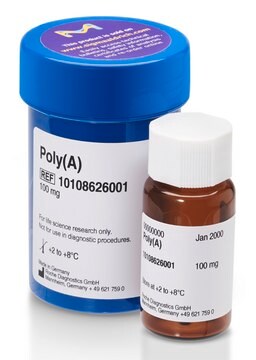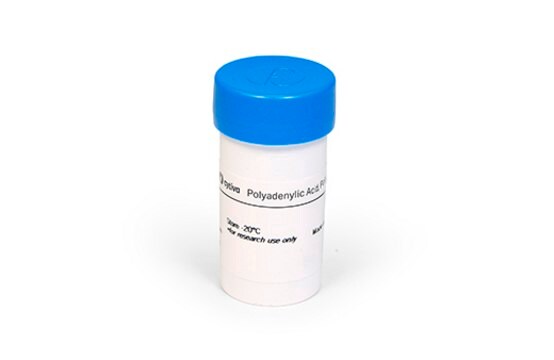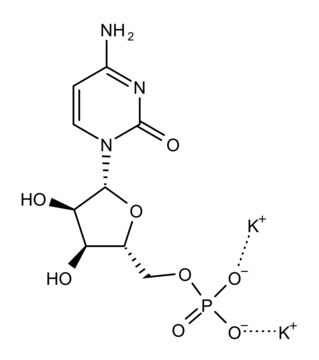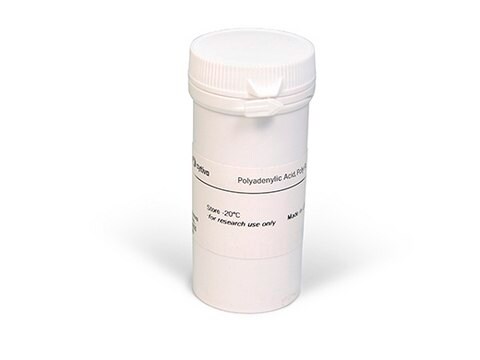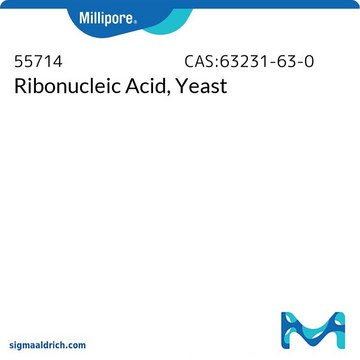P9403
poly(A)
Synonim(y):
Polyadenylic acid potassium salt, Poly(A) potassium salt
Zaloguj sięWyświetlanie cen organizacyjnych i kontraktowych
About This Item
Polecane produkty
Szukasz podobnych produktów? Odwiedź Przewodnik dotyczący porównywania produktów
Zastosowanie
Polyadenylic acid (poly-A) is used to evaluate binding on cationic liposomes doped with non-ionic nucleolipids. Poly-A is used in small molecule mRNA targeted drug development to evaluate the binding of potential therapeutic agents such as the Isoquinoline group of alkaloids.
Uwaga dotycząca przygotowania
Prepared from ADP with polynucleotide phosphorylase
Ta strona może zawierać tekst przetłumaczony maszynowo.
Kod klasy składowania
11 - Combustible Solids
Klasa zagrożenia wodnego (WGK)
WGK 3
Temperatura zapłonu (°F)
Not applicable
Temperatura zapłonu (°C)
Not applicable
Środki ochrony indywidualnej
Eyeshields, Gloves, type N95 (US)
Wybierz jedną z najnowszych wersji:
Masz już ten produkt?
Dokumenty związane z niedawno zakupionymi produktami zostały zamieszczone w Bibliotece dokumentów.
Prabal Giri et al.
Molecular bioSystems, 6(1), 81-88 (2009-12-22)
The use of small molecules to specifically control important cellular functions through binding to nucleic acids is an area of major current interest at the interface of chemical biology and medicinal chemistry. The polyadenylic acid [poly(A)] tail of mRNA has
Tian-Li Duan et al.
Cells, 8(8) (2019-08-08)
Poly(A)-specific ribonuclease (PARN), a multifunctional multi-domain deadenylase, is crucial to the regulation of mRNA turnover and the maturation of various non-coding RNAs. Despite extensive studies of the well-folding domains responsible for PARN catalysis, the structure and function of the C-terminal
Prabal Giri et al.
Mini reviews in medicinal chemistry, 10(7), 568-577 (2010-05-27)
After fifty years of DNA targeting through intercalators and groove binders and related studies now the current focus is in RNA targeting. Polyadenylic acid [poly(A)] tail of mRNA has been recently established as a potential drug target due to its
Natallia Makarava et al.
Acta neuropathologica communications, 6(1), 92-92 (2018-09-14)
Last decade witnessed an enormous progress in generating authentic infectious prions or PrPSc in vitro using recombinant prion protein (rPrP). Previous work established that rPrP that lacks posttranslational modification is able to support replication of highly infectious PrPSc with assistance
Polyadenylic acid binding on cationic liposomes doped with the non-ionic nucleolipid Lauroyl Uridine.
Cuomo F, Ceglie A, Colafemmina G, et al.
Colloids and Surfaces, B: Biointerfaces, 82, 277-282 (2011)
Nasz zespół naukowców ma doświadczenie we wszystkich obszarach badań, w tym w naukach przyrodniczych, materiałoznawstwie, syntezie chemicznej, chromatografii, analityce i wielu innych dziedzinach.
Skontaktuj się z zespołem ds. pomocy technicznej